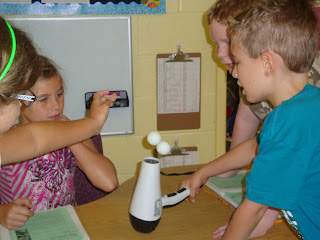 Today, our young scientists were busy at work in their laboratory. They were seeking the answer to their essential question, How can the pull of gravity be overcome? They were given a hairdryer, three ping pong balls, and a cotton ball. Their task was to set the hair dryer on cool, point it toward the ceiling, and then carefully put a ping pong ball in the stream of air.
Today, our young scientists were busy at work in their laboratory. They were seeking the answer to their essential question, How can the pull of gravity be overcome? They were given a hairdryer, three ping pong balls, and a cotton ball. Their task was to set the hair dryer on cool, point it toward the ceiling, and then carefully put a ping pong ball in the stream of air.
They concluded that the force of air was stronger than the pull of gravity so the ping pong ball floated in the air stream. Then, they turned the hair dryer slightly to the left and slightly to the right, and noticed that the ping pong ball would follow the air stream and stay suspended, unless, like one group discovered, the stream of air was not strong enough. In that case, the pull of gravity would be stronger and the ping pong ball would be pulled toward Earth.
Next, the young scientists tried floating two or more ping pong balls in the air stream. Some groups were successful while others were not. The discussion behind the mixed results provided an excellent way to introduced the independent variables (What changed?), dependent variables (What did not change?), and constants in this hands on lab.
In addition, the students discovered that floating the cotton ball had a different result. In their exploration, they also discovered that the cotton ball would stick to the bottom of the hairdryer and stop the flow of air. When this occurred, the forced air would be weaker than the pull of gravity.
 In our analysis of the lab,students quickly made the connection that the air stream was stronger than the pull of gravity on the mass of the ping pong ball. We asked, "What do you think would happen if we tried the same thing with a golf ball or even a basketball?" Students concluded that the mass of the golf ball and basketball would be too much for the air stream and gravity would pull it to the ground. However, they also recognized that with a great enough force, they would be able to get the golf ball and basketball to levitate. Some students thought that a leaf blower would work to levitate heavier objects.
In our analysis of the lab,students quickly made the connection that the air stream was stronger than the pull of gravity on the mass of the ping pong ball. We asked, "What do you think would happen if we tried the same thing with a golf ball or even a basketball?" Students concluded that the mass of the golf ball and basketball would be too much for the air stream and gravity would pull it to the ground. However, they also recognized that with a great enough force, they would be able to get the golf ball and basketball to levitate. Some students thought that a leaf blower would work to levitate heavier objects.
In Closing, one student shared that he once was in a machine that made him levitate! He's bringing a video of the experience in for the class to see. How exciting!
Today's lab explored Bernoulli's Principle, the principle that allows heavier-than-air objects like airplanes to fly. Bernoulli discovered that the faster air flows over an object, the less the air pushes on the surface of the object and so the lower the pressure. In this lab, gravity is pulling on the ball while the pressure from the forced air pushes up on the ball. The forces are balanced,so the ball hovers in the air. You can move the hair dryer from side to side, and the ball will stay hovering in mid-air until one of the forces is stronger than the other.
The students loved the lab and the learning was evident. We hope your young scientist shared their enthusiasm. Furthermore, if you are a student reading this post, we'd love it if you leave us a comment and tell us what you liked most about today's gravity lab.











Science was very fun yesterday. I liked the experiment because it was hands on. I can't believe we got two balls to levitate.
ReplyDeleteNicole
dear mrs.shall and miss. russell I loved the gravity expirments over the week but this was one of my favorites because you usally dont see things like a air stream and a floating ping pong ball working together to over come gravityevery day i thought it was super cool love your creative amazing chef lexie
ReplyDelete